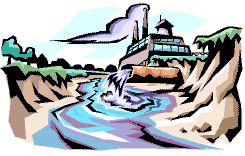Rain and Water Quality
 Pure natural water is formed mainly by evaporation from seas and lakes. As warm water vapour rises it meets cooler air and condenses into water droplets (just like hot water vapour rising from a bath and condensing into droplets on the cool bathroom walls). The water droplets begin to dissolve a whole range of substances in the atmosphere, such as gases, airborne dust particles and salt from sea spray. When this water eventually falls to earth as rain it acquires other substances from rock weathering and by drainage through fields and woods. Unfortunately, man’s misuse of the waterways to dispose of industrial wastes and sewage also allows other, often undesirable, substances to affect the composition of the water.
Pure natural water is formed mainly by evaporation from seas and lakes. As warm water vapour rises it meets cooler air and condenses into water droplets (just like hot water vapour rising from a bath and condensing into droplets on the cool bathroom walls). The water droplets begin to dissolve a whole range of substances in the atmosphere, such as gases, airborne dust particles and salt from sea spray. When this water eventually falls to earth as rain it acquires other substances from rock weathering and by drainage through fields and woods. Unfortunately, man’s misuse of the waterways to dispose of industrial wastes and sewage also allows other, often undesirable, substances to affect the composition of the water.
Atmospheric gases
Many atmospheric gases dissolve in water to some extent and carbon dioxide is one of the most important. It dissolves readily to form carbonic acid, giving a weakly acidic solution. This chemical reaction has important consequences, not only for the eventual chemical content of water, but also for other chemical and biological reactions that occur in the aquatic environment. The naturally acidic nature of rain allows it to bring other, less reactive, substances into solution. (The pH of naturally formed rainwater is about 5.6 but, as we shall see, local atmospheric and landscape variations can alter it significantly before it gets anywhere near our fish ponds.) The affinity between carbon dioxide and water has many far-reaching effects on water quality, playing a major role in plant and animal respiration and pH buffering.

industrial chimney belching smoke
Sea spray and local dust particles can have a major influence on the composition of rain. Coastal areas may have quite high levels of dissolved sea salt, with substantially higher levels of sodium and chloride ions than inland areas. Likewise, dusty land surfaces can affect rain. For instance, rain from chalky areas near the coast often have higher than normal levels of calcium caused by the chalky soils in these areas. Indeed, during long dry spells the amount of calcium is often sufficient to neutralise the naturally acidic rain, leading, unusually, to slightly alkaline rain!
As we are all aware, atmospheric pollution can have a major effect on the composition of rainwater, typically caused by heavy metals such as lead, zinc or chromium from industrial processes, although such effects are more likely to be local, not widespread. Fossil-fuel burning is a more global cause of atmospheric pollution, the two most important gases being sulphur dioxide (mainly from coal burning) and nitrous oxides from vehicle exhausts and oil-burning power stations. These gases can react with rain to form strongly acidic solutions, giving acid rain. Some parts of the world, including the UK have recorded pH values as low as 2.1, due to acid rain. Some fish keepers outside the UK have started to cover their ponds to protect them from acid rain.
Rain picks up significant amounts of nitrogen, sulphur and sodium in the atmosphere. At this stage it is likely to be very soft. So we see that rain – which we like to think of as pure water – is already a complex chemical mixture before it hits the earth (or our fish ponds). Without going into details at this stage, let me advise that you do not collect soft acidic rain for fish pond water changes.
Rock weathering
Most of the inorganic substances in tapwater come from rock weathering. As the nature of the local rock varies, so does the content of the local water. The degree and rate of rock weathering depends on several factors. There are broadly speaking two types of rock of interest -igneous and sedimentary. (I have not included metamorphic rock as it weathers in much the same way as igneous rock.)

Snow-capped mountain
Igneous rocks have been formed by volcanic action and are common in mountainous regions. They are extremely hard and dissolve slowly, helped by the slight acidity of naturally occurring rain. Water draining from igneous rock will contain most of the common metals, such as magnesium, calcium, sodium and potassium, but usually only in small amounts. The degree or amount of rock weathering that occurs has two important effects on the character of the drainage water.
Water hardness is determined mainly by the amount of dissolved magnesium and calcium ions there are. Soft water is described as such because of the small amounts of dissolved “water hardness” forming ions. This has important consequences for the fish-keeper. When these ions are dissolved they tend to neutralise the acidity of rain. If only small amounts of rock are dissolved (as with igneous rocks), the drainage water tends to still be acidic -although the local water board may well adjust this at the water purification plant.
Sedimentary rocks, on the other hand, are built from a jumble of rocks and some organic debris. Chalk or limestone are common examples. These rocks usually dissolve fairly easily so drainage waters contain high concentrations of the major ions, such as calcium and magnesium. Again, the slight acidity of rain is important in this process. Most of these types of rock have an abundance of calcium carbonate which, being alkaline, raises the pH of the water. The water draining from such rocks is usually neutral or alkaline. The high level of dissolved ions thus makes the water ‘hard’.
The action of rain on natural rock and the subsequent weathering plays a major role in determining the overall content or chemistry of the water going into our fish ponds. Rock weathering is an important factor in determining both the pH (acidity /alkalinity) and ‘hardness’ of water. Both of these parameters are important to fish health.
Drainage water

Industrial waste discharging into river
Water dissolves many more substances as it drains from land to river or reservoir, the number and type of substances depending on the land usage. In an agricultural area there will be run-off from fields. Often, water draining from such areas is high in nitrates and phosphates from fertilisers and may contain man-made  pesticides and herbicides. Intensive stock-rearing units may yield ‘slurry’ which penetrates the streams and groundwaters. Water treatment plants often release treated sewage into streams and rivers. A typical effluent will contain high levels of ammonia, nitrate and phosphate. Stream flora usually oxidise most of the ammonia, but significant amounts of nitrate and phosphate will remain. Industry still releases many wastes into fresh waters, the nature and amount of which depend on the industry. Unbelievably, we are still pumping toxic substances such as cyanide, oil, heavy metals and formaldehyde into our waters.
pesticides and herbicides. Intensive stock-rearing units may yield ‘slurry’ which penetrates the streams and groundwaters. Water treatment plants often release treated sewage into streams and rivers. A typical effluent will contain high levels of ammonia, nitrate and phosphate. Stream flora usually oxidise most of the ammonia, but significant amounts of nitrate and phosphate will remain. Industry still releases many wastes into fresh waters, the nature and amount of which depend on the industry. Unbelievably, we are still pumping toxic substances such as cyanide, oil, heavy metals and formaldehyde into our waters.
